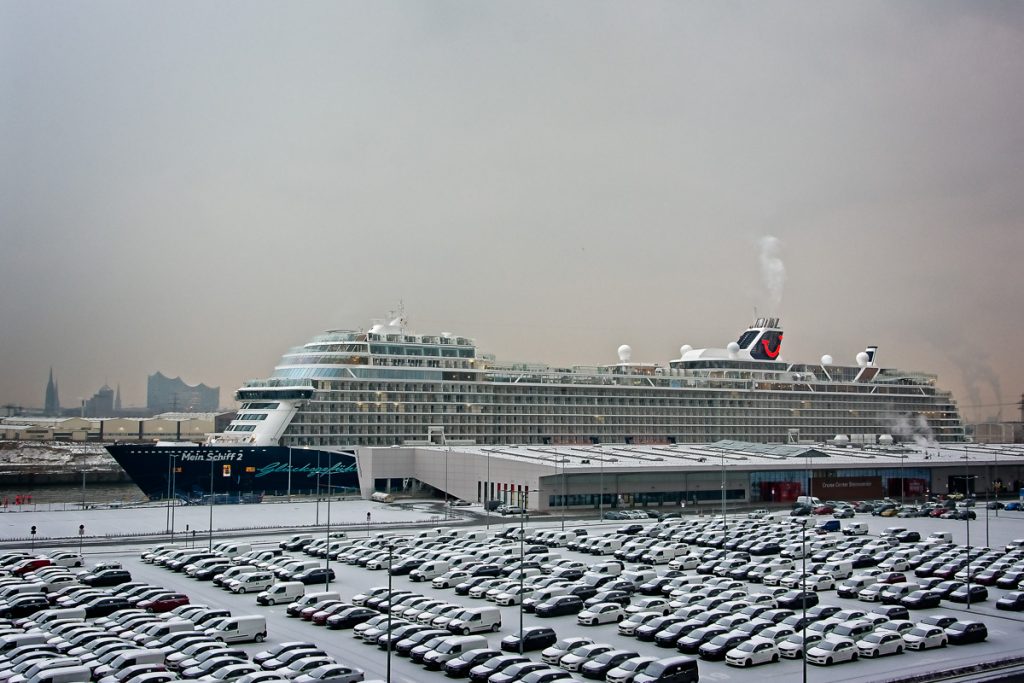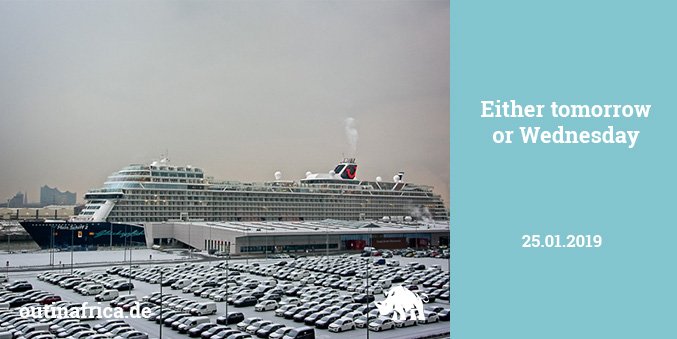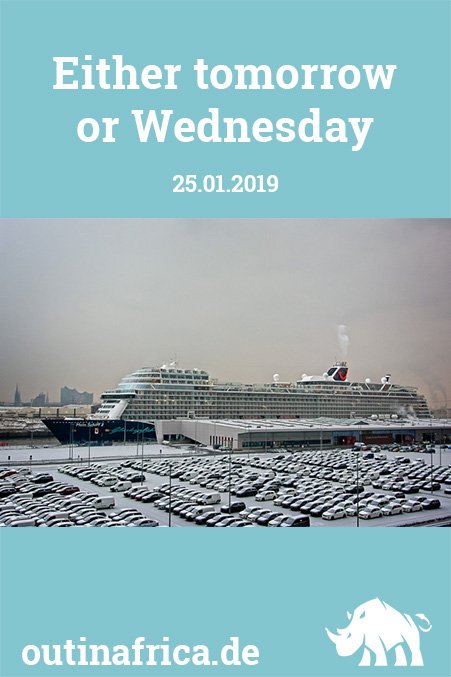This post is also available in:  Deutsch (German)
Deutsch (German)
After getting up, I look out of the window and see that in the night a huge cruise ship from TUI had moored. It is at least twice as long as the Bright Sky. It is called “Mein Schiff 2“. The whole upper deck with nine floors looks like a pigeon shed. One cabin is next to the other. Upstairs there are a few deluxe cabins. Right at the top in the back are the common areas like the party room and restaurants. Well, I’ve always wanted to go with a ship, but I have no desire at all for such a luxury vessel.

On the other side, at the container port, an even bigger container ship has moored. It is called “Cosco Capricorn” and comes from Hong Kong. Seven cranes unload and load it at the same time. On the shipping chart on the Internet, the Bright Sky looks very small against the two giants.
The trend is towards ever-larger ships. The engineer has told us that the city wants to demolish the Köhlbrand for the big ships can also pass through. The car traffic will then go underground through a multi-lane tunnel. I regret that they want to demolish such an imposing structure as this bridge, but the engineer reassured me with “They are still in the planning phase. It’s like the BER.”
We have a particularly exciting breakfast.
We’ll meet the new captain. He speaks an excellent, almost British English and immediately comes across as likeable.
Then comes the man from MACS, the shipping company. His name is Petersen, and he is a real Hamburger.
Mr Petersen explains to us what happened to the engine. The oil that lubricates and cools the engine was contaminated with water. The movement and the heat created an emulsion like mayonnaise. This grease, which is almost like an adhesive, caused the cylinders to malfunction. Also, the exhaust valves could not open any more. The consequence was that the exhaust fumes went in the wrong direction to the turbocharger and gave it a blow.
First, the machine was cleaned. As the engineer told the other day, all the oil was drained. Then some sailors had to crawl into the engine to remove the emulsion from the inside. The problem is that our machine is very modern – like a common rail diesel. Of course, this has the advantages of saving fuel and being more environmentally friendly, but also the disadvantages of having many tubes. All of them were clogged and had to be cleaned of the emulsion. But the machine soon worked again.
What stops us are the damaged turbochargers, of which the engine has one per cylinder, a total of seven. Four of them are out of order. A turbocharger is also a complex machine consisting of many individual parts. Usually, they replace the entire turbocharger. The problem is that we only have one spare turbocharger, but we need four. In the meantime, they’ ve called Singapore and Houston to obtain turbochargers. But they fail so rarely that they are not everywhere available. Now there are two possibilities:
One is to get the spare turbochargers from the sister ships of the Bright Sky and install them. But two of the sister ships are in South Africa. Until the turbochargers are here in Hamburg, it is Tuesday, until they are installed, we have Wednesday.
The other possibility is to disassemble the turbochargers ourselves and reassemble them with spare parts. The parts are available and already on board, but the crew is not sure that they have everything they need and that the repair can be done quickly.
Both possibilities will be tackled in tandem. At the moment they are trying to repair the turbochargers in the engine room. At the same time, the turbochargers from the sister ships are being flown in.
If the repairs are successful, we leave tomorrow. If not, next Wednesday.
It is crucial for the shipping company to send the ship completely repaired to sea and not to run the risk of having to enter a port somewhere in West Africa (for example Lagos). First, a repair there would take at least four weeks; second, there would be a significant security problem because of the piracy that often occurs there.
Pierre and I add up the travel days: 1.5 days from Hamburg to Antwerp. There we will lie for 2.5 days to unload and load freight. Afterwards, we continue to Walvis Bay. Porto is omitted. Antwerp-Walvis Bay takes at least 19 days. That’s a total of 23 days. Pierre’s flight to Madagascar leaves on 21 February. We would have to dock in Walvis Bay at the latest on 20 February. We have to leave at the latest on Tuesday, 29 January. If the repair experiment does not succeed, we will depart at the earliest on Wednesday, 30 January. In this case, Pierre can no longer travel with us. So if we don’t leave tomorrow, he will leave the ship, get his ticket refunded and then fly to South Africa to visit Madagascar.
I chat with Mr Petersen about containers and container ships. A few days ago, 270 containers, some with toxic substances, were lost from a container ship and then floundered around in the nature reserves of the North Sea. Anita and I want to ship our belongings with a container in a few weeks. We are worried. Mr Petersen tells me that mariners take cargo securing seriously, but also how a ship may lose containers:
There are two ways of securing containers. One is the traditional one. To be able to connect containers stacked on top of each other, a safety mechanism is fitted at the top of all four corners of a container. The next container is then stacked on top, the safety mechanisms are locked in place, and the containers are connected. Then the worker must be lifted onto the upper container, set the safety mechanisms in place again and so on. However, this procedure is time-consuming and also questionable from the point of view of occupational safety.
The large container ships no longer want people to climb around on container stacks and have therefore developed a different method: The container is lifted briefly at the quay, and dock workers attach the safety mechanisms at the bottom of all four corners. The crane then lifts the container onto the ship and the safety mechanism engages with the container underneath as a result of the impact when the container is set down. When unloading, the device must disengage again, and this also happens by utilizing an impact.
Mr Petersen says that one should never think that a container ship, because of its size and weight, is running more smoothly at sea than a smaller freighter like the Bright Sky. Container ships are rocked back and forth during storms just like small freighters, and because of their length and height, there are quite different leverage effects on the vessel. The large ships also offer the wind more surface to be attacked. In any case, container ships swing like all other ships, and sometimes the high waves give the vessel an impact. We now know that an impact unlocks the safety mechanism of containers, and that is what can happen when a high wave hits a ship in an unfortunate way. The device is opened, the lever action on the stack of containers does the rest, and the cargo falls overboard.
At lunch, we get to know the new captain’s wife, who will accompany her husband on this journey. Unfortunately, unlike her husband, she does not speak English. German is as foreign to her as Polish is to me. That is a pity. Except “Hello”, “How are you”, “Please” and “Thank you” we can’t talk to each other.
There’s silence at dinner. Even our talkative German engineer is much more reserved than usual. Perhaps this is because the repair of the turbochargers does not have the desired success. “Four steps forwards, eight backwards” he sums up the atmosphere during the repair work.
In the evening, Germany plays against Norway in the Handball World Championship semi-final. I want to see if I can watch the match on TV. Pierre told me that he got channels on his TV set, but they’re all Polish. I think to myself that the Poles might also show the World Cup. But I’m hopelessly overwhelmed with the TV set, receiver and remote controls. In the end, I give up and have friends and family send me updates via WhatsApp.
Then the captain himself calls me and tells me that the engineers have completed the repairs and the pilot has been scheduled for tomorrow morning at eight o’clock. So we are ready to depart. That’s how fast it can go! I’m still sceptical and won’t believe it until we get going.
Would you like to see an overview of all articles about my journey on the cargo ship Bright Sky? Click here for a table of contents.



Leave a Reply